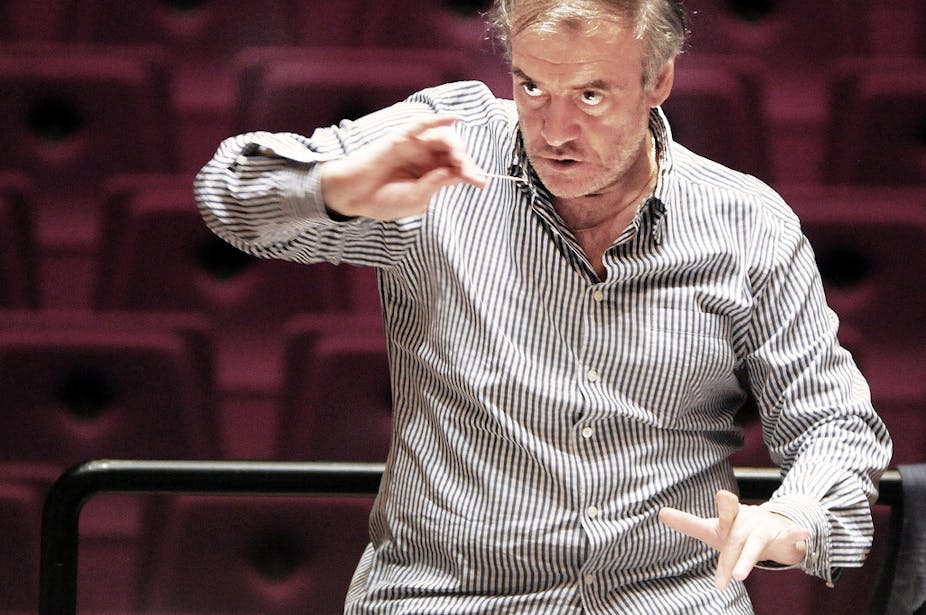Conducting is essentially a phenomenon associated with Western classical music. As a rule, rock and jazz bands do not employ a conductor unless they are teaming up with a symphony orchestra. Conductors are also used in big jazz bands and in some non-Western traditions such as Turkish classical music.
In the modern day, the conductor has three important roles, which are to:
- beat time
- make interpretive decisions
- oversee administrative aspects of the musical ensemble.
So how did it all begin?
In the 15th and 16th centuries, composers were writing very complex polyphonic music for vocal groups, with two or more independent melodies sounding against each other.
Because it’s difficult to sing without getting lost, a visible beat – called the “tactus” – would be given by the singers. They would tap their foot, hand or finger, or some singers would lead the choir by tapping a staff on the floor.
The practice of using a staff led to the untimely death of French conductor/composer Jean-Baptiste Lully (1632-1687) who stabbed himself in the foot with the long staff he used for beating time and died by the ensuing gangrenous abscess that formed in his foot as a result of the injury.

During the 16th century, music began to be coordinated using vertical motions of the arm. The arm was moved up and down to indicate the beat, the speed, and sometime the pitch.
With the rise of instrumental ensembles in the 17th and 18th centuries, the first violin would lead the group, using the bow and moving the violin vigorously to indicate the tempo (speed), the number of beats per bar, and the metre.

The violin is really the precursor to the baton. As orchestras grew in size, directing from the first violin desk, especially in the opera pit, became very difficult.
The bow eventually translated into the baton. It is reported that the German conductor Louis Spohr (1784-1859), was the first to use the baton in 1820 at a concert in London.
Gradually the techniques of conducting with a baton began to be standardised.
Technique and role of the conductor
Conductors nowadays use a podium, raising them to a height in which all the performers can see their hand and baton movements. The baton itself is very light and usually made of fibre glass with a cork handle.
One of the most important roles of the conductor is to establish the beat at the beginning of the music. The conductor does this with a “preparatory beat”, like the breath of preparation the singer draws in before singing the first note.
The preparatory beat establishes the tempo, character, shape and style of the music and ensures that everyone starts together. Sometimes a conductor will give the preparatory beat as two bars for nothing. Or else she or he will give it as an upbeat before the first downbeat.
The basic movements of the baton or stick are vertical and lateral. The underlying principle is that there is an imaginary point in the air where the beat lands. This is referred to as the “ictus”.
Australian conductor Richard Gill says the ictus is the way the music is prepared and the way the conductor shows the beat. The ictus is critical as it indicates the time of the preparation and the cut-off points in the music.
While the right hand maintains the beat, the left hand works independently to indicate other things about the music, such as the phrasing, dynamics and articulation.
The conductor will raise his or her left hand to indicate a “crescendo” (gradually get louder) and lower it to indicate a “diminuendo” (gradually get softer). He or she will bounce the left hand in the air to indicate “staccato” (short, clipped notes) or move it smoothly to indicate “legato” (smooth) passages.
The left hand is also used for cuing, showing the players the ictus just before their cues. He or she will often use other kinds of gestures and facial expressions to prepare the cue, sometimes eyeballing the player just before the cue.

Conductor as a god
In some ways the orchestra epitomises the hierarchy par excellence. The conductor leads the rehearsals and is ultimately responsible for the interpretation of the music.
Sometimes it might seem that the players are not looking at the conductor. But if you look at them closely you will see they have him or her in their line of sight while they are simultaneously looking at their music.
Before commencing the rehearsals with the players, the conductor will spend time learning the music and knowing exactly what every player is expected to do.
The conductor is critical to the functioning of the music ensemble and a good or bad performance hinges on how well the conductor performs.

